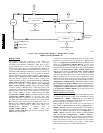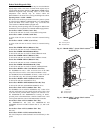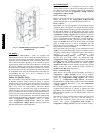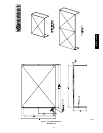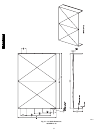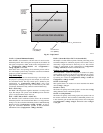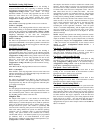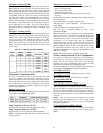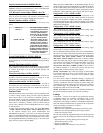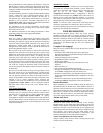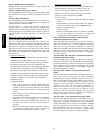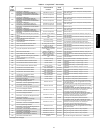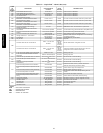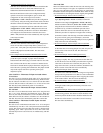
36
Global Schedule Broadcast (BROD"B.GS)
If this configuration is set to ON and the schedule number
(SCH.N) is between 65 and 99, then the control will broadcast the
internal time schedule once every 2 minutes.
CCN Broadcast Acknowledger (BROD"B.ACK)
If this configuration is set to ON, then when any broadcasting is
done on the bus, this device will respond to and acknowledge.
Only one device per bus can be configured for this option.
Schedule Number (SCH.O"SCH.N)
This configuration determines what schedule the control may
follow.
SCH.N = 0 The control is always occupied.
SCH.N = 1 The control follows its internal
time schedules. The user may
enter any number between 1
and 64 but it will be overwritten
to “1” by the control as it only
has one internal schedule.
SCH.N = 65-99 The control is either set up to
receive to a broadcasted time
schedule set to this number or
the control is set up to broad
cast its internal time schedule
(B.GS) to the network and this is
the global schedule number it is
broadcasting. If this is the case,
then the control still follows its
internal time schedules.
Accept Global Holidays? (SCH.O"HOL.G)
If a device is broadcasting the time on the bus, it is possible to
accept the time yet not accept the global holiday from the broadcast
message.
Override Time Limit (SCH.O"OV.TL)
This configuration allows the user to decide how long an override
occurs when it is initiated. The override may be configured from 1
to 4 hours. If the time is set to 0, the override function will
become disabled.
Timed Override Hours (SCH.O"OV.EX)
This displays the current number of hours left in an override. It is
possible to cancel an override in progress by writing “0” to this
variable, thereby removing the override time left.
SPT Override Enabled? (SCH.O"OV.SP)
If a space sensor is present, then it is possible to override an
unoccupied period by pushing the override button on the T55 or
T56 sensor. This option allows the user to disable this function by
setting this configuration to NO.
Demand Limit
Demand Limit Control may override the cooling algorithm to limit
or reduce cooling capacity during run time. The term Demand
Limit Control refers to the restriction of machine capacity to
control the amount of power that a machine will use. This can save
the owner money by limiting peaks in the power supply. Demand
limit control is intended to interface with an external network
system. This is through a CCN Loadshed POC Device or writing
to network points.
To limit stages through network writes, the points Run Status
→COOL→MAX.C and Run Status→HEAT→MAX.H are forced
on the network through CCN points MAXCSTGS and
MAXHSTGS respectively. Force these to the desired maximum
stages of cooling/dehumidification and heating, respectively. When
there is no force on these points, they automatically reset to allow
all cooling/dehumidification and heating stages to be used. These
points are reset at power−on/reset (POR).
When using the Loadshed POC to do Demand Limiting, the cool
and heat stage limits under both Redline and Loadshed conditions
can be set individually with configuration decisions. If the active
stages is greater then the loadshed or redline configurations when a
loadshed or redline command is given, the unit will remove stages.
Configuration→CCN→LDSH→S.GRP
This is the Loadshed Group Number and corresponds to the
loadshed supervisory devices that resides elsewhere on the CCN
network and broadcasts loadshed and redline commands to its
associated equipment parts. This variable will default to zero which
is an invalid group number. This allows the loadshed function to be
disabled until configured.
Configuration→CCN→LDSH→R.MXC
This configuration tells the unit the maximum cooling stages
allowed to be on during a redline condition.
Configuration→CCN→LDSH→S.MXC
This configuration tells the unit the maximum cooling stages
allowed to be on during a loadshed condition.
Configuration→CCN→LDSH→R.MXH
This configuration tells the unit the maximum heating stages
allowed to be on during a redline condition.
Configuration→CCN→LDSH→S.MXH
This configuration tells the unit the maximum heating stages
allowed to be on during a loadshed condition.
The two Demand Limiting methods can be active simultaneously.
The lowest cool and heat stage limits imposed by either method are
applied, and these ”effective stage limits” are shown in the points
CSTGLIMT (Run Status→COOL→LMT.C) and HSTGLIMT
(Run Status→HEAT→LMT.H), respectively. In normal running
mode, these limits will prevent stages from being added, or stages
to be removed, as applicable. In test mode, these limits are ignored,
and the user may continue to operate all stages. The point
MODEDMDL (Run Status→MODE→D.LMT) is used to show if
any Demand Limiting is in effect that prevents the unit from
operating either cooling or heating at full−capacity.
NOTE: MODEDMDL may reflect that staging is NOT limited
even though Loadshed is active, or the network points are being
forced, if the stage limits in effect are not less than the stages
present in the unit.
If a more drastic mode of Demand Limiting is required, the
network point HVACDOWN (Run Status→MODE→HV.DN) can
be used to prohibit the unit from selecting any HVAC mode, thus
preventing the operation of the supply fan, compressors, condenser
fans, and heat stages. This point must also be forced, and is reset
automatically when not forced, and at POR.
NOTE: HVACDOWN can be used as an immediate shutdown of
the unit before limiting capacity (ex. Generator switching).
Linkage
ComfortLink controls do not require any configuration settings
to establish linkage with a Linkage Coordinator. This is done
automatically when the unit’s bus and element address are
configured in the Linkage Coordinator’s LINKAGE configuration
table. The linkage information that is supplied to the ComfortLink
unit by the Linkage Coordinator is as follows:
Reference zone temperature
Reference zone occupied biased heating and cooling set points
Reference zone unoccupied heating and cooling set points
Composite occupancy mode
The unit will control the equipment based on this information and
in return will provide the Linkage Coordinator with the following
data:
Operating mode − Cooling, Heating, Free Cooling, Fire
Shutdown Evacuation, or Off
Supply−air temperature
Optimal Start Bias time (Based on worst case zone)
48/50PG and PM



